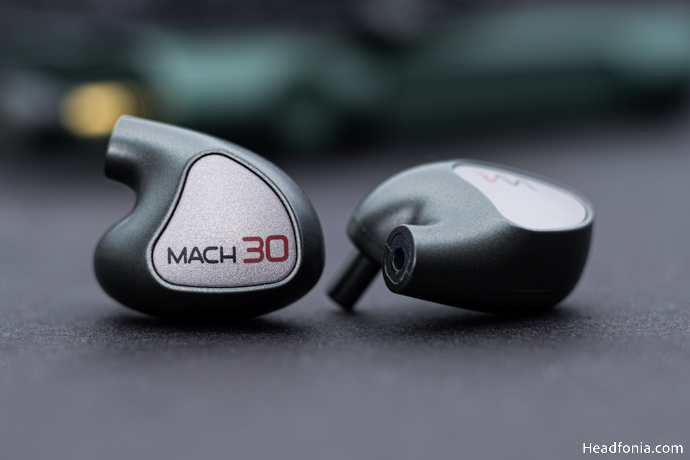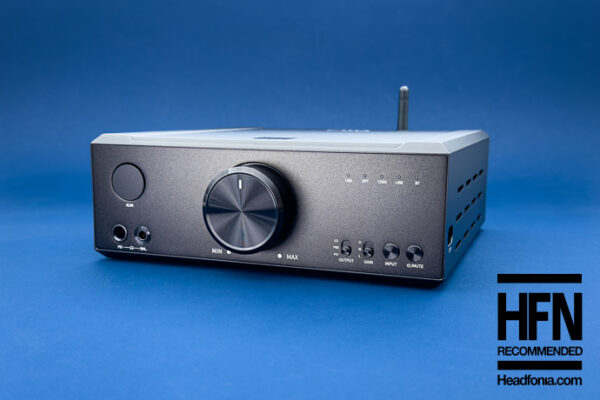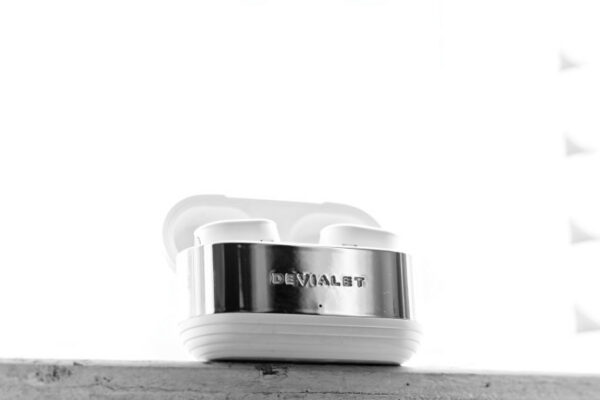Design & Build Quality
The Westone Mach 30 shares the same build, size, and design as the Mach 70 and 80 we reviewed a few weeks ago. The only aesthetic difference is that the gray tone of the polycarbonate body is one shade lighter.
From the E series that Westone developed and produced for Shure to the W and UM series, Westone has always come up with compact, comfortable, and ergonomic monitors. The Mach series is no exception. After the lightweight, compact, and oval-shaped W series, Westone did not change the form of the monitors’ inner side facing the ear, but it is clear that there is a slight design change on the outer side. The new polycarbonate Mach series adopts a dual-color design, and all models from 10 to 80 come in the same black-gray dual-color design. The outward-facing portion of the monitors has a triangular shape resembling a custom IEM’s faceplate. Although this part is plastic, the color, and finish making it look like an anodized coating on metal.
Compared to the W series, which is the old-generation equivalent of the Mach series, the design form factor seems to be the same, which is fantastic because Westone’s monitors were always one of the most comfortable offerings on the market. W and UM series was extraordinarily light and had a durable case. The W series had a design that featured interchangeable faceplates, and I would’ve liked to see that with the Mach series too.
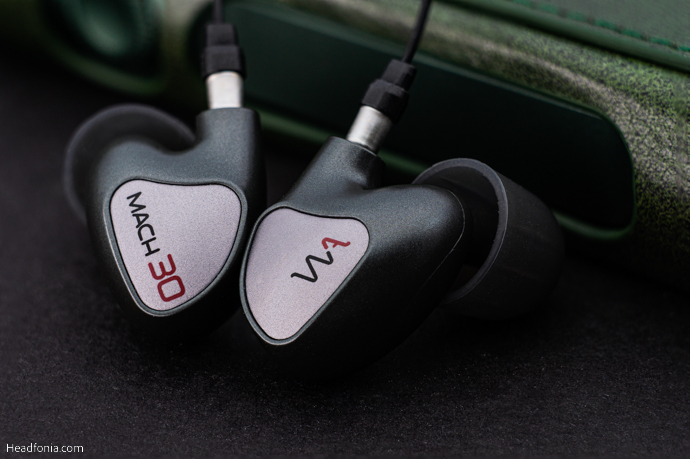
Despite housing multiple drivers inside, the shell of the Mach 30 is very compact. I can easily say that the new chassis is a clear improvement over the previous gen. The old W series’ case joints were much more visible, and the MMCX connectors were the most sensitive part of the earphones. Most of the issues originated from these connector parts. Apart from that, the MMCX sockets could oxidize, and sound interruptions could occur in case of prolonged use combined with insufficient care. The new chassis looks much more monolithic than the old one, and the joint points are not visible at all. Furthermore, I believe the switch from MMCX to the T2 connector was an excellent decision. The T2 is a much better solution than the MMCX and 2-Pin in terms of robustness, ergonomics, and signal transmission. It is also sweat-proof and does not become loose after continuous use.
As for fit and ergonomics, I honestly forgot I had the earphones on many times during my time with the product. There are five sizes of ear tips and two different textures to select from, and my relatively big ear canals love the orange-colored silicone tips. They are extremely comfortable for me. Additionally, the microphonic effect of the Linum cable is close to zero, and when you combine that with a lightweight chassis, you get exceptional comfort.
The Mach series provide impressive passive isolation thanks to their shape and cone-shaped tips. Naturally, the included foam ear tips provide more isolation compared to the silicone tips, but I didn’t feel the need for more isolation as it was already excellent. Foam tips may be more suitable for on-stage and outdoor use. To summarize this section in one sentence; the Mach 30 offers an improved design and an improved material quality compared to the previous generation, while not compromising on the comfort we all love and got used to.
Westone Mach 30 – Sound
The Mach 70 and 80 were nicely tuned monitors with specific audiences in mind, while the Mach 30 has a much more affordable price tag & an approach to sound that is more generally appreciable by the masses. It features a slightly warm, fairly balanced signature with a limited extension on both ends of the spectrum. I tested the Mach 30 with Topping’s E70V & L70 combo, as well as Chord’s remarkable Mojo 2. Let’s take a closer look at the performance.
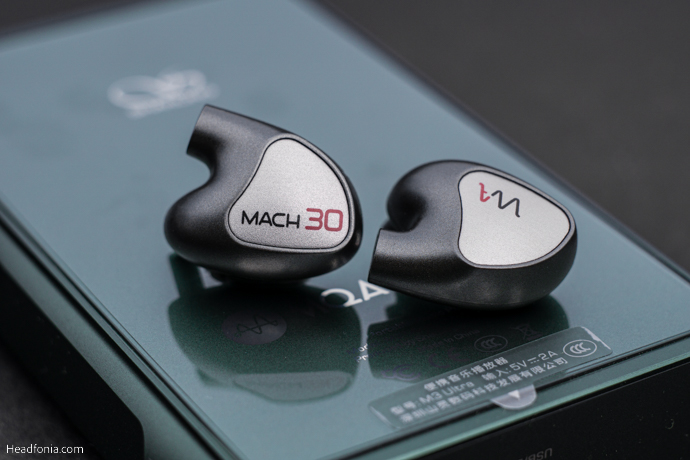
Bass
The Mach 30 offers an adequate amount of bass that can be labelled as linear and somewhat flat. The impact is limited, and the extension is somewhat rolled off. The Mach 30 does not extend as low as I’d like. Some of the instruments, especially those with thicker instrument bodies, such as trombone or cello, lacks weight, due to the insufficient mid-bass quantity. The Mach 30’s bass hits fast, and recuperates with agility. It is snappy, fast, and reminds me of W30’s bass, only less accentuated. If you are primarily listening to rock & metal, you may find this tuning adequate for your tastes.
Midrange
The midrange of the Mach 30 is clean and linear. Both the male and female vocals show good clarity and have adequate tonality. Instruments that have no mid-bass dependency sound natural and articulate. The electric guitar tonality are great and I hear remnants of Westone’s house sound in this region. However, the magic ends as we approach the upper midrange. Right around here, there is a strange peak that becomes much clearer when you pair it with neutral sources. I had this problem with many neutral, flat sources in my inventory. This peak makes the Mach 30 more shouty and thus damages its technical capability.
Treble
Treble reproduction of the Mach 30 is quite good, compared to the rest of the spectrum. The treble is defined, clean and resolving with good enough extension to the top octave. The treble is not prominent, does not shadow any other region, and stays controlled no matter the genre. The well-done treble tuning contributes to the feeling of air.
Technical Capability
On a technical level, the Mach 30’s performance is not particularly impressive. Even if the Mach 30 impresses as the first ‘high-fidelity’ IEM a non-audiophile listens to, its $499 price tag won’t easily win over veteran audiophiles. The $499 price bracket is an incredibly intense arena of competition and rivalry and there are many alternatives to compare the Mach 30 with. In fact, let’s take a look at those.
Comparison
vs. Oracle MKII ($589 USD)
The Oracle MKII is a competitively priced IEM that features a 5-driver tribrid configuration. 1DD+2BA+2EST equipped IEM comes with a full-acrylic custom shell with handmade faceplates. Sound-wise, there are major differences between both of the units. The Oracle MKII comes with a better treble extension, especially in the high treble region. It reaches the top octave effortlessly and without any sharpness. Oracle’s upper midrange is more controlled and much more refined. It is also technically superior with a much larger stage. It positions the instruments with more finesse and there are plenty of air between the instruments therefore it handles congestion a lot better than the Mach 30. Thanks to the DD, the percussions are cleaner, more impactful and have more authority on the stage. I believe that Oracle’s 90 USD premium is easy to justify here.
vs. XENNS Mangird Top ($530 USD)
The Mangird Top utilizes a 8BA+1DD configuration and is a direct competitor to the Mach 30 with its 530 USD price tag. XENNS is not a new company and have established products like Tea, Tea 2 that have many fans worldwide. The Top is their latest creation. In terms of performance, Top features superior stereo separation, better imaging and layering, and is noticeable from the very first listen. The Top also have an elevated bass response that can reach deep without bleeding into the midrange. The bass is impactful and its slam is impressive. For EDM, pop, R&B, and rock, The Top is a great choice that can easily be picked over the Mach 30.
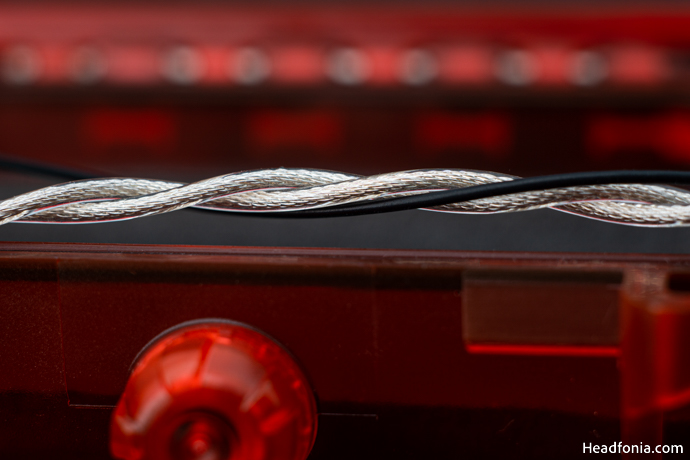
BaX vs. Common Litz Upgrade Cable – Thin!
Last Words
Mach 30’s unique polycarbonate shell boasts superior ergonomics compared to anything on the market. With the Linum BaX cable, it is an extremely lightweight and comfortable set that can be easily used anywhere. It’s unfortunate that it lacks the performance leap we saw in the Mach 70 and Mach 80. Still, keep an eye out for discounts. If you can get it in the $300 range, it is an option to consider.
Pros
- Inclusion of the Linum’s BaX Cable
- Fairly balanced tuning
- Rich accessories package
- Polycarbonate body is light & durable
Cons
- Limited upper midrange
- Not the best extension on both ends of the spectrum
- Stereo separation can be improved
Page 1: Westone, Mach 30, Packaging & Accessories, Linum BaX
Page 2: Design, Build & Fit, Sound, Low, Mid, High, Technical Capability, Comparison, Last Words





